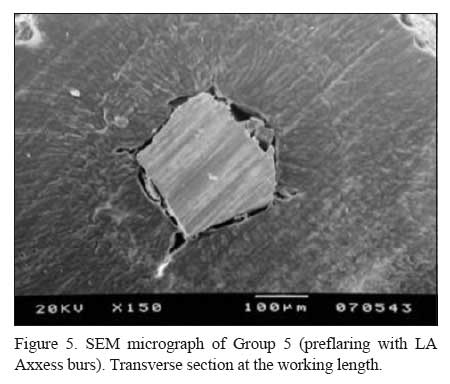The purpose of this study was to investigate the influence of cervical preflaring on determination of the initial apical file in mesiobuccal roots of maxillary molars. Fifty first molars with degree of curvature of the mesiobuccal root between 10° and 15° were utilized. After standard access opening and removal of pulp tissue, the working length (WL) was determined at 1 mm from the root apex. Five groups (n=10) were formed at random, according to the type of cervical preflaring performed. In group 1, the size of the initial apical file was determined without cervical preflaring. In groups 2 to 5, the cervical and middle thirds of the canals were preflared with Gates-Glidden drills, K3 Orifice Opener instruments, ProTaper instruments and LA Axxess burs, respectively. Canals were sized manually with K-files, starting with size 08 K-files, inserted passively up to the WL. File sizes were increased until a binding sensation was felt at the WL and the size of the file was recorded. The binding instruments were fixed into the canals at the WL with methylcyanacrylate. Cross-sections of the WL region were examined under scanning electron microscopy and the discrepancies between the canal diameter and the diameter of first file to bind at the WL were calculated using UTHSCSA ImageTool software. Data were analyzed statistically by ANOVA and multiple comparisons were done by Tukey's HSD post-hoc test. Significant differences (p<0.001) were found among the groups. The major discrepancy was observed for the group without preflaring (mean 0.1543 mm ± 0.0216). Cervical preflaring with LA Axxess burs produced the least discrepancies between the canal size and the diameter of the initial apical instrument (mean 0.026 mm ± 0.0037), followed by ProTaper files (mean 0.0567 mm ± 0.0354). Canals preflared with Gates-Glidden drills and K3 Orifice Opener instruments showed statistically similar discrepancy results to each other (p>0.05) (means 0.1167 mm ± 0.0231 and 0.1313 mm ± 0.0344, respectively). In conclusion, preflaring of the cervical and middle thirds improved the determination of the initial apical instrument. Canals preflared with LA Axxess burs showed a more accurate binding of the files to the anatomical diameter at the WL in the mesiobuccal roots of maxillary first molars.
cervical preflaring; initial apical file; anatomic diameter






